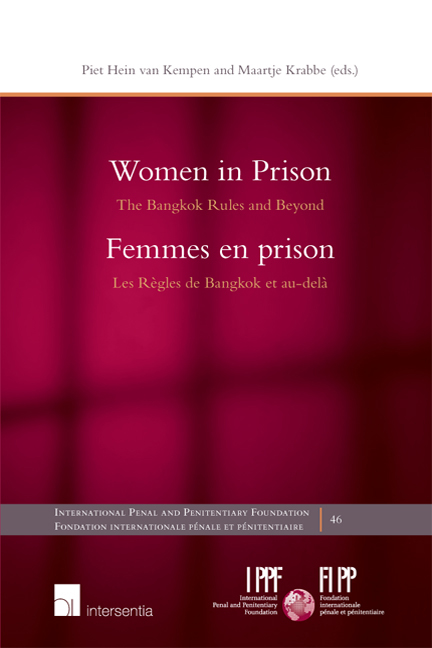Book contents
- Frontmatter
- Foreword
- Avant-propos
- Acknowledgements
- Remerciements
- Contents
- Part I Introductory Synthesis and Analyses: 1ÈRE Partie Synthèse ET Analyses Introductives
- Part II Themes: 2ÈME Partie Thèmes
- Part III National Reports: 3ÈME Partie Rapports Nationaux
- Appendix The Bangkok Rules: Annexe Règles De Bangkok
- The International Penal and Penitentiary Foundation: History and Purpose
Foreword
Published online by Cambridge University Press: 25 September 2018
- Frontmatter
- Foreword
- Avant-propos
- Acknowledgements
- Remerciements
- Contents
- Part I Introductory Synthesis and Analyses: 1ÈRE Partie Synthèse ET Analyses Introductives
- Part II Themes: 2ÈME Partie Thèmes
- Part III National Reports: 3ÈME Partie Rapports Nationaux
- Appendix The Bangkok Rules: Annexe Règles De Bangkok
- The International Penal and Penitentiary Foundation: History and Purpose
Summary
For a long time, the international community has been cooperating to develop common standards on the treatment of offenders. The efforts of the International Penal and Penitentiary Commission (IPPC) in affiliation with the League of Nations, and later the work of the International Penal and Penitentiary Foundation (IPPF), led to the adoption of the first international set of rules in 1955, namely the Standard Minimum Rules for the Treatment of Prisoners (SMR). The adoption of these rules marked a significant step in ensuring a rights-based treatment for those deprived of liberty.
Over five decades the SMR were regarded as a key reference of generally accepted, good principles underlying the treatment of prisoners and the management of correctional institutions. However, there has been increased international recognition that the specific needs of women were not adequately recognized in the criminal justice system. Across the globe, women prisoners share a common background which shapes their pathways to prison. Many have similar histories of abuse and trauma, and limited access to education and work. Some have a history of substance abuse, mental and/or physical health problems. Without appropriate support and gender-sensitive treatment, women prisoners are at risk of re-victimization while in prison and of reoffending once released.
The adoption of the “United Nations Rules for the Treatment of Women Prisoners and Non-custodial Measures for Women Offenders” or the “Bangkok Rules” by the United Nations General Assembly in December 2010 represented a major paradigm shift in the outlook on women's correction facilities. The Rules take into account existing standards and norms including the SMR and the United Nations Standard Minimum Rules on Non-custodial Measures (the Tokyo Rules), while incorporating elements of the Convention on the Elimination of All Forms of Discrimination against Women and the Convention on the Rights of the Child.
Since their adoption, the Bangkok Rules have been promoted and applied in various countries. In the past few years, we have seen efforts being made to improve domestic legislation and practices. Also, many countries have increasingly invested in research and capacity-building activities. Such efforts have broadened our knowledge of the characteristics and backgrounds of women in prison and have increased the visibility of the Bangkok Rules in academia and among practitioners.
- Type
- Chapter
- Information
- Women in PrisonThe Bangkok Rules and Beyond, pp. v - viPublisher: IntersentiaPrint publication year: 2017



